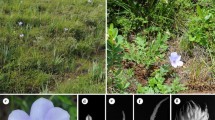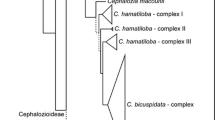Abstract
On the basis of 1,290 bp sequences of the chloroplast generbcL, a molecular phylogeny of seven of nine genera of the Celtidaceae and four of six genera of the Ulmaceae was produced. These data were analyzed together with some other urticalean genera using three methods (i.e., maximum parsimony, maximum likelihood, and neighbor joining methods). Maximum likelihood topology among 18 trees obtained indicated that the Urticales are monophyletic with its common clade splitting basally into two: one leading to a line comprisingAmpelocera (traditionally placed in Celtidaceae) and Ulmaceae, and the other leading to a line comprising the remaining genera of Celtidaceae, Moraceae, and other Urticales. Ulmaceae, to whichAmpelocera is a sister group, are monophyletic, as supported by many lines of morphological evidence. In contrast to Ulmaceae, the monophyly of Celtidaceae (excludingAmpelocera) was not supported, and resolution of relationships of Celtidaceae with other Urticales, as well as of those within the family, is left for future study.
Similar content being viewed by others
References
Albert, V.A., Chase, M.W. andMishler, B.D. 1993. Character state weighting for cladistic analysis of protein-coding DNA sequences. Ann. Missouri Bot. Gard.80: 752–766.
Adachi, J. andHasegawa, M. 1994. MOLPHY ver. 2.2. Institute of Statistical Mathematics, Tokyo.
Bousquet, J., Strauss, S.H. andLi, P. 1992. Complete congruence between morphological andrbcL-based molecular phylogenies in birches and related species (Betulaceae). Mol. Biol. Evol.9: 1076–1088.
Chase, M.W., Soltis, D.E., Olmstead, R.G., Morgan, D., Les, D.H., Mishler, B.D., Duvall, M.R., Price, R.A., Hills, H.G., Qiu, Y.-L., Kron, K.A., Rettig, J.H., Conti, E., Palmer, J.D., Manhart, J.R., Sytsma, K.J., Michaels, H.J., Kress, W.J., Karol, K.G., Clark, W.D., Hedroen, M., Gaut, B.S., Jansen, R.K., Kim, K.-J., Wimpee, C.F., Smith, J.F., Furnier, G.R., Strauss, S.H., Xiang, Q.-Y., Plunkett, G.M., Soltis, P.S., Swensen, S., Williams, S.E., Gadek, P.A., Quinn, C.J., Eguiarte, L.E., Golenberg, E., Learn, G.H.Jr., Graham, S.W., Barrett, S.C., Dayanandan, S. andAlbert, V.A. 1993. DNA sequence phylogenetics of seed plants: an analysis of the plastid generbcL. Ann. Missouri Bot. Gard.80: 528–580.
Chernik, V.V. 1981. Pseudomonomeric gynoecium of the Ulmaceae and Celtidaceae representatives. Bot. Zhurn. (Moscow & Leningrad)66: 958–966 (In Russian).
Cronquist, A. 1981. An Integrated System of Classification of Flowering Plants. Columbia Univ. Press, New York.
Cronquist, A. 1988. The Evolution and Classification of Flowering Plants. 2nd ed. New York Botanical Garden, New York.
Felsenstein, J. 1995. PHYLIP (Phylogeny Inference Package) version 3.56c. University of Washington, Seattle.
Frascaria, N., Maggia, L., Michaud, M. andBousquet, J. 1993. TherbcL gene sequence from chestnut indicates a slow rate of evolution in the Fagaceae. Genome36: 668–671.
Giannasi, D.E. 1978. Generic relationships in the Ulmaceae based on flavonoid chemistry. Taxon27: 331–344
Grudzinskaya, I.A. 1967. Ulmaceae and reasons for distinguishing Celtidoideae as a separate family Celtidaceae Link. Bot. Zhurn.52: 1723–1748 (In Russian with English summary).
Gunter, L.E., Kochert, G. andGiannasi, D.E. 1994. Phylogenetic relationships of the Juglandaceae. Plant Syst. Evol.192: 11–29.
Hasebe, M., Ito, M., Kofuji, R., Iwatsuki, K. andUeda, K. 1992. Phylogenetic relationships in Gnetophyta deduced fromrbcL gene sequences. Bot. Mag. Tokyo105: 385–391.
Higgins, D.G. 1994. Clusta/W. EMBL, Heidelberg.
Martin, P.G. andDowd, J.M. 1993. Using sequences ofrbcL to study phylogeny and biogeography ofNothofagus species. Aust. Syst. Bot.6: 441–447.
Morgan, D.R., Soltis, D.E. andRobertson, K.R. 1994. Systematic and evolutionary implications ofrbcL sequence variation in Rosaceae. Amer. J. Bot.81: 890–903.
Oginuma, K., Raven, P.H. andTobe, H. 1990. Karyomorphology and relationships of Celtidaceae and Ulmaceae (Urticales). Bot. Mag. Tokyo103: 113–131.
Oginuma, K. andTobe, H. 1995. Karyomorphology of some Moraceae and Cecropiaceae (Urticales). J. Plant Res.108: 313–326.
Omori, Y. andTerabayashi, S. 1993. Gynoecial vascular anatomy and its systematic implications in Celtidaceae and Ulmaceae (Urticales). J. Plant Res.106: 249–258.
Qiu, Y.-L., Chase, M.W. Les, D.H., Hills, H.G. andParks, C.R. 1993. Molecular phylogenetics of the Magnoliidae: a cladistic analysis of nucleotide sequences of the plastid generbcL. Ann. Missouri Bot. Gard.80: 587–606.
Sharp, A.J. 1958.Mirandaceltis, a new genus from Mexico (1). Bol. Soc. Bot. Mex.23: 38–42.
Soltis, D.E., Soltis, P.S., Clegg, M.T. andDurbin, M. 1990.rbcL sequence divergence and phylogenetic relationships in Saxifragaceae sensu lato. Proc. Natl. Acad. Sci. USA87: 4640–4644.
Sotis, D.E., Morgan, D.R., Grable, A., Soltis, P.A. andKuzoff, R. 1993. Molecular systematics of Saxifragaceae sensu stricto. Amer. J. Bot.80: 1056–1081.
Sytsma, K.J., Conti, E., Nepokroeff, M., Pires, J.C., Qiu, Y-L. andChase, M.W. 1996. Urticales:rbcL sequences clarify placement in Rosidae, composition, and familial relationships (Abstract no. 562). Amer. J. Bot.83: 197.
Sweitzer, E.M. 1971. Comparative anatomy of the Ulmaceae. J. Arnold Arb.52: 523–585.
Swofford, D.L. 1993. PAUP: Phylogentic Analysis Using Parsimony, ver.3.1.1. The Illinois Natural History Survey, Champaign.
Takahashi, M. 1989. Pollen morphology of Celtidaceae and Ulmaceae: a reinvestigation.In P.R. Crane and S. Blackmore, eds., Evolution, Systematics, and Fossil History of the Hamamelidae, vol. 2. Clarendon Press, Oxford. pp. 253–265.
Takaso, T. andTobe, H. 1990. Seed coat morphology and evolution in Celtidaceae and Ulmaceae (Urticales). Bot. Mag. Tokyo103: 25–41.
Terabayashi, S. 1991. Vernation patterns in Celtidaceae and Ulmaceae (Urticales), and their evolutionary and systematic implications. Bot. Mag. Tokyo104: 1–13.
Thorne, R.F. 1992. An updated phylogenetic classification of the flowering plants. Aliso13: 365–389.
Ueda, K., Kosuge, K. and Tobe, H. 1994. Systematic position of Ulmaceae and Celtidaceae, and their generic relationships (Abstract no. 3aA7). Proc. 58th Ann. Meet. Bot. Soc. Jpn.: 292 (in Japanese).
Webb, D.M. andKnapp, S.J. 1990. DNA extraction from a previously recalcitrant plant genus. Plant Mol. Biol. Rep.8: 180–185.
Author information
Authors and Affiliations
Corresponding author
Rights and permissions
About this article
Cite this article
Ueda, K., Kosuge, K. & Tobe, H. A molecular phylogeny of celtidaceae and ulmaceae (Urticales) based onrbcL Nucleotide sequences. J. Plant Res. 110, 171–178 (1997). https://doi.org/10.1007/BF02509305
Received:
Accepted:
Issue Date:
DOI: https://doi.org/10.1007/BF02509305




